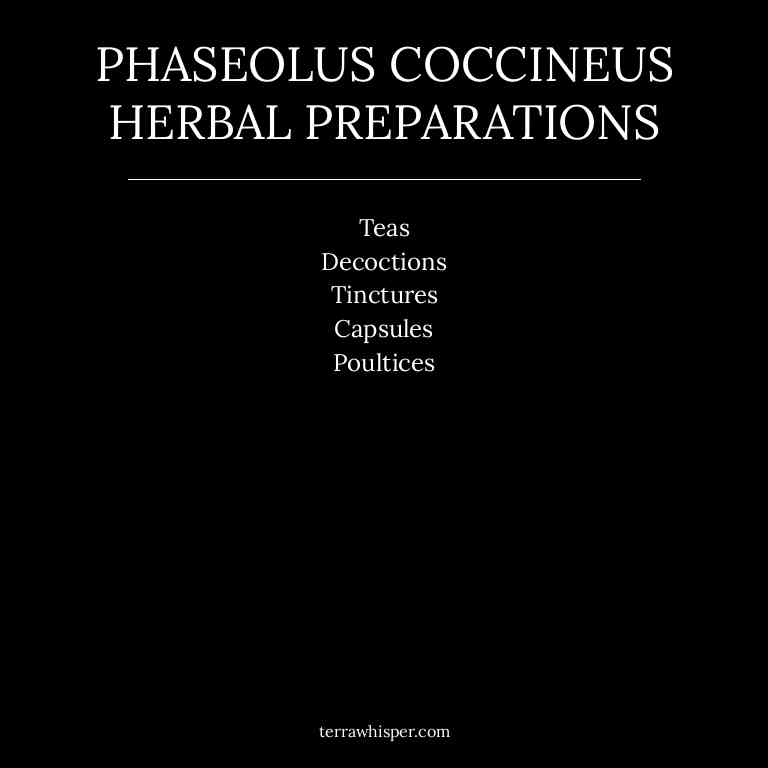Phaseolus Coccineus Uses, Benefits, And Remedies

Phaseolus coccineus, commonly known as the scarlet runner bean, is a flowering plant native to the Americas, prized for its edible beans and medicinal properties.
This herb is known for its potential to support digestive health, reduce inflammation, and enhance immune function.
The bioactive constituents in Phaseolus coccineus include alkaloids, flavonoids, and saponins, which contribute to its therapeutic effects.
Herbal preparations such as infusions, decoctions, and tinctures can be made from its leaves and seeds to harness its health benefits.
This page analize the most important medicinal aspects of Phaseolus coccineus.
- Health Benefits
- Bioactive Constituents
- Medicinal Parts
- Herbal Preparations
- Side Effects of phaseolus coccineus
Health Benefits
Phaseolus coccineus support digestive health due to its high content of dietary fiber and bioactive compounds that promote the growth of beneficial gut bacteria, aiding in regular bowel movements and reducing gastrointestinal discomfort.
It is rich in fiber, which adds bulk to stool, improves intestinal motility, and helps prevent constipation while also supporting a healthy gut microbiome. It regulates blood sugar by containing compounds like phaseolins and lectins that slow the absorption of carbohydrates, preventing spikes in blood glucose levels. It lowers blood pressure through its potassium content, which helps balance sodium levels and relax blood vessel walls, improving circulation.
It supports heart health by reducing cholesterol levels and inflammation, thanks to its antioxidant and anti-inflammatory properties that protect cardiovascular tissues.
The 10 best health benefits of Phaseolus coccineus are shown in the image below.

The list below give a brief description of the 10 best health benefits of Phaseolus coccineus.
- Support Digestive Health: Phaseolus coccineus contains compounds that promote healthy digestion by aiding in the breakdown of food and supporting gut health.
- Eat Fiber Rich: This herb is rich in dietary fiber, which helps improve bowel movements and supports a healthy digestive system.
- Regulate Blood Sugar: Phaseolus coccineus may help in managing blood sugar levels due to its potential impact on insulin sensitivity and glucose metabolism.
- Lower Blood Pressure: The herb contains nutrients that may contribute to lowering blood pressure by improving vascular function and reducing oxidative stress.
- Support Heart Health: Phaseolus coccineus may support heart health by reducing cholesterol levels and improving overall cardiovascular function.
- Lower Cholesterol Levels: This herb has been associated with reducing LDL cholesterol levels, which can help prevent heart disease and improve blood lipid profiles.
- Boost Immune System: Phaseolus coccineus contains antioxidants and other bioactive compounds that may help strengthen the immune system and protect against infections.
Bioactive Constituents
Phaseolus coccineus fiber plays a crucial role in promoting digestive health by aiding in the regulation of bowel movements and supporting a healthy gut microbiome.
This legume is also a rich source of plant-based protein, making it a valuable addition to vegetarian and vegan diets, as it provides essential amino acids necessary for muscle repair and growth. One of the notable compounds found in Phaseolus coccineus is phytohemagglutinin, a lectin that has been studied for its potential immune-boosting properties and its ability to stimulate white blood cell activity. Additionally, the herb contains various flavonoids, which are powerful antioxidants that help neutralize free radicals in the body, reducing oxidative stress and potentially lowering the risk of chronic diseases.
These medicinal constituents collectively contribute to the overall health benefits of Phaseolus coccineus, supporting both digestive and immune functions while offering potential protective effects against cellular damage.
The 11 best bioactive constituents of Phaseolus coccineus are shown in the image below.

The list below give a brief description of the 10 best bioactive constituents of Phaseolus coccineus.
- Fiber: Fiber is a type of carbohydrate that the body cannot digest, aiding in digestion and promoting a feeling of fullness.
- Protein: Protein is essential for the growth, repair, and maintenance of body tissues, and is a key component of many bodily structures.
- Phytohemagglutinin: Phytohemagglutinin is a lectin that can agglutinate red blood cells and has been studied for its potential immune-modulating properties.
- Flavonoids: Flavonoids are a group of plant secondary metabolites known for their antioxidant and anti-inflammatory properties.
- Lectins: Lectins are proteins that bind to carbohydrates and may have various biological activities, including immune system modulation.
- Quercetin: Quercetin is a flavonoid with strong antioxidant and anti-inflammatory properties, known for its potential health benefits.
- Phytic Acid: Phytic acid is a compound found in plant seeds that can bind to minerals and may affect their absorption in the body.
- Kaempferol: Kaempferol is a flavonoid with antioxidant and anti-inflammatory properties, and may have potential health benefits.
- Saponins: Saponins are plant compounds that can have detergent-like properties and may have antimicrobial and anti-inflammatory effects.
- Ursolic Acid: Ursolic acid is a triterpene compound known for its anti-inflammatory, antioxidant, and potential anticancer properties.
- Gallic Acid: Gallic acid is a polyphenolic compound with strong antioxidant properties and may have antimicrobial and anti-inflammatory effects.
Medicinal Parts
Phaseolus coccineus seed is one of the most commonly utilized medicinal parts of this plant, known for its high nutritional value and various therapeutic properties.
The seeds are rich in proteins, vitamins, and minerals, making them beneficial for improving overall health and supporting digestion. In traditional medicine, they have been used to treat ailments such as anemia, respiratory disorders, and digestive issues due to their antioxidant and anti-inflammatory effects. The seeds also contain compounds like saponins and alkaloids, which contribute to their medicinal value.
Additionally, the seeds are often consumed as a vegetable, providing a good source of dietary fiber and essential nutrients.
Herbal Preparations
Phaseolus coccineus teas are a popular method of preparing this herb, often made by steeping dried leaves or seeds in hot water for several minutes.
This method is favored for its simplicity and ability to extract mild, calming properties associated with the plant. The tea is typically consumed warm and may be used to support digestive health or as a general tonic. Decoctions, which involve boiling the herb for a longer period, are another preparation method that can enhance the extraction of more robust compounds.
Tinctures, made by soaking the herb in alcohol, offer a concentrated form of the plant's active components and are often used for their potency. Capsules provide a convenient and standardized way to consume Phaseolus coccineus, making it easy to incorporate into daily routines. Poultices, created by crushing fresh leaves and applying them to the skin, are used topically for their potential anti-inflammatory and healing properties. Each preparation method allows for different therapeutic applications, depending on the desired effect and individual needs.
Whether consumed internally or applied externally, Phaseolus coccineus offers a variety of ways to harness its traditional herbal benefits.
The 10 best herbal preparations of Phaseolus coccineus are shown in the image below.

The list below give a brief description of the 10 best herbal preparations of Phaseolus coccineus.
- Teas: Red kidney bean tea is used to support digestive health and may help alleviate symptoms of bloating and gas due to its natural enzymatic properties.
- Decoctions: Red kidney bean decoctions are traditionally used to aid in the treatment of inflammation and as a source of nutrients, particularly protein and minerals.
- Tinctures: Red kidney bean tinctures are utilized for their potential antioxidant properties and may support immune function when used as a complementary therapy.
- Capsules: Red kidney bean capsules provide a convenient way to consume the herb for its potential digestive benefits and nutritional support.
- Poultices: Red kidney bean poultices are applied topically to reduce inflammation and soothe skin irritations, leveraging the herb's natural anti-inflammatory properties.
Side Effects of phaseolus coccineus
Phaseolus coccineus induces nausea due to the presence of certain alkaloids and lectins that can irritate the gastrointestinal tract and disrupt normal digestive processes.
Phaseolus coccineus causes stomach upset because its compounds may interfere with the digestive enzymes, leading to discomfort and bloating. Phaseolus coccineus causes digestive discomfort as it contains compounds that may slow down digestion and cause gas formation in the intestines.
Phaseolus coccineus induces allergic reactions in some individuals because it contains proteins that can trigger an immune response in sensitive people.
The 13 most common side effects of Phaseolus coccineus are shown in the image below.

The list below give a brief description of the 13 most common side effects of Phaseolus coccineus.
- Induces Nausea: Consuming Phaseolus coccineus may cause feelings of nausea, often due to its high fiber content and potential irritants in the plant.
- Causes Stomach Upset: The herb can lead to stomach discomfort, possibly due to its natural compounds that may irritate the gastrointestinal tract.
- Causes Digestive Discomfort: Phaseolus coccineus may cause general digestive issues, including bloating and cramping, due to its effects on the digestive system.
- Induces Allergic Reactions: Some individuals may experience allergic reactions to Phaseolus coccineus, including symptoms like itching or hives.
- Leads To Bloating: The herb can cause bloating due to its high fiber content, which may slow digestion and lead to gas buildup.
- Brings Heartburn: Phaseolus coccineus may trigger heartburn by increasing stomach acid production or irritating the esophagus.
- Leads To Diarrhea: The herb's high fiber and natural compounds may cause loose stools or diarrhea in some individuals.
- Causes Skin Irritation: Contact with the plant may cause skin irritation, possibly due to its alkaloids or other irritant compounds.
- Induces Skin Rashes: Some people may develop skin rashes upon contact with Phaseolus coccineus, indicating an allergic or irritant response.
- Triggers Gas Pains: The herb can lead to increased gas production, causing discomfort and pain in the abdomen.
- Triggers Vomiting: In some cases, Phaseolus coccineus may induce vomiting, likely due to its irritant properties on the stomach lining.
- Leads To Throat Swelling: In rare cases, the herb may cause throat swelling, which could be a severe allergic reaction.
- Causes Eye Irritation: Contact with the plant may irritate the eyes, leading to redness, itching, or discomfort.